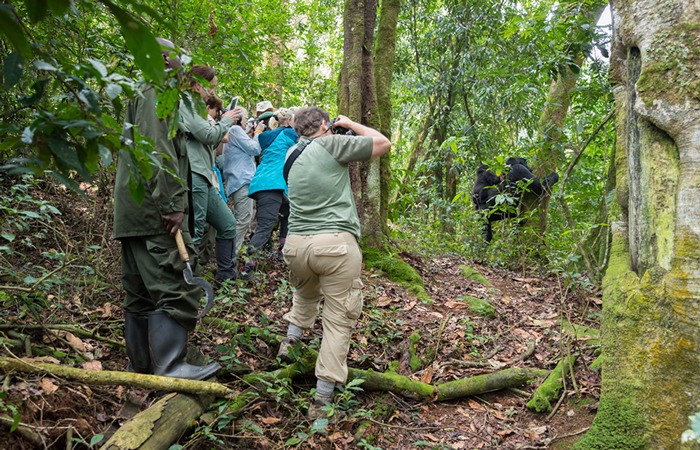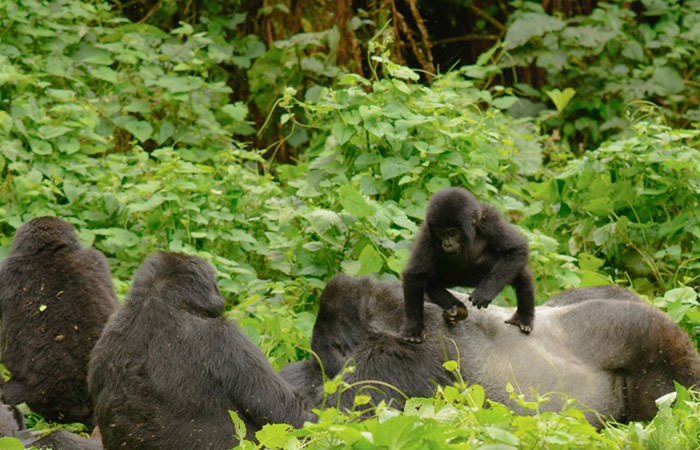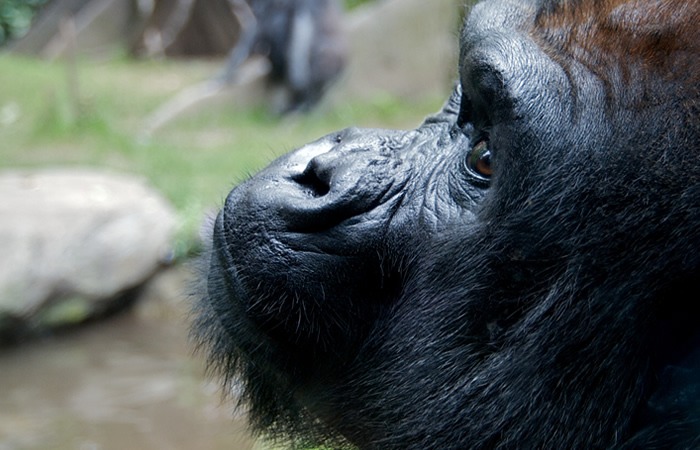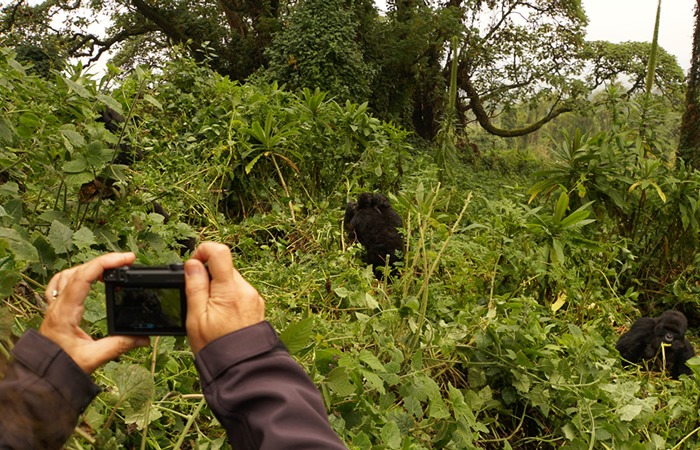Gorillas belong to the great ape family which also includes human beings, chimpanzees, bonobos and orangutans. Apes have larger brains and because of that are generally more intelligent than smaller primates. Gorilla are divided into two major species – The western and eastern gorilla. The western gorilla is divided into two subspecies – The Cross river gorilla and the Western Lowland gorilla. Eastern gorillas are categorized into two subspecies too – The Mountain gorilla and the Eastern lowland gorilla.
Gorilla species and 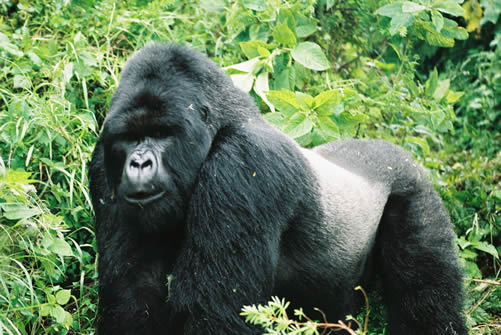 subspecies are named according to the location in which they are found. One thing is common in all cases and that is that they live in the tropical forests of sub-Saharan Africa. Western gorillas found in the western part of the Africa’s central tropical rain forests while the Eastern gorillas are found in the east-central part of Africa’s tropical rain-forests. Gorillas are very fascinating because of various reasons. One is that they share 98% of their DNA with we humans. Second is because their huge bulk and overall disposition makes them very intriguing. We will be focusing on mountain gorillas for now because they are the most visited and observed of the great apes.
subspecies are named according to the location in which they are found. One thing is common in all cases and that is that they live in the tropical forests of sub-Saharan Africa. Western gorillas found in the western part of the Africa’s central tropical rain forests while the Eastern gorillas are found in the east-central part of Africa’s tropical rain-forests. Gorillas are very fascinating because of various reasons. One is that they share 98% of their DNA with we humans. Second is because their huge bulk and overall disposition makes them very intriguing. We will be focusing on mountain gorillas for now because they are the most visited and observed of the great apes.
Mountain gorillas live in the mountainous areas and forests of East/Central Africa. They are the most endangered of the gorilla sub-species after the Cross River Gorilla in Cameroon and Nigeria. Only about 1000 remain in the wild and they can only found in Rwanda, Uganda or the Democratic Republic of Congo. In Congo, they are found in the Virunga National Park while in Rwanda they can be seen in the Volcanoes National Park. Uganda has two national parks where mountain gorillas can be spotted. They include Mgahinga and Bwindi Impenetrable National Park. Bwindi has the largest population of mountain gorillas, followed by Volcanoes National Park, Virunga National Park and Mgahinga National Park. Overall, Uganda has about half of the remaining mountain gorillas. These four national parks are close to each other and generally lie in areas of high altitude (7,200 to 14,100 feet above sea level) with very dense forests comprising of the equatorial forests, montane forests, bamboo forests and swampy grassland.
Physical Characteristics of Mountain Gorillas
Mountain gorillas are the second largest subspecies of gorillas. The largest are the eastern lowland gorillas – also known as the Grauer’s gorilla. Physically, mountain gorillas are dark in color and have a large skull with prominent nostrils. They have thick coats which protect them from the cold weather in higher altitudes. The alpha males or adult males have a silver color on their backs and because of that are called silverbacks. Males are almost twice as large as females. A male can weigh up to 190kgs while females average 100kgs. Mountain gorillas are very powerful primates and a grown silverback is four times stronger than an adult male. They are quadruple primates that move with the help of all their four limbs. They can move upright occasionally but only for a short distance.
Mountain gorillas are only active during the day. They start their day at sunrise and retire at sunset. They are nomads who do not stay in a place for more than a day. Every morning, they leave their nests permanently and move to other areas in search of food. Most of the day is spent foraging, resting and grooming. The youthful and young gorillas spend a lot of time playing with each other by tussling and flipping. Because of their large bodies, gorillas need to eat a lot in a day. Like most gorilla subspecies, they mainly feed on tree shoots, leaves, branches, flowers, fruits and on some occasions small insects like termites. Mountain gorillas usually feed early in the morning and take a short afternoon nap before resuming their feeding session till evening when they build a new nest for the night. Each adult gorilla builds its own nest from tree branches and leaves. The young ones sleep with their mothers or share a nest with the silverback.
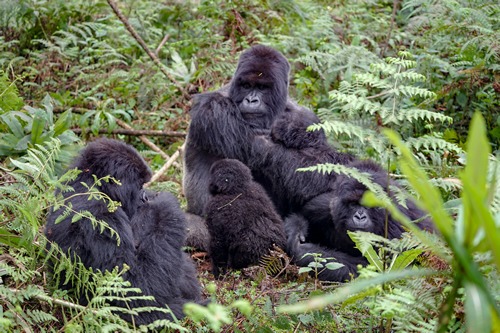 Mountain gorillas are terrestrial animals. They therefore spend most of their time on the ground. The nests are built on the ground even though they are excellent tree climbers. Younger gorillas love climbing trees compare to the adults. Adult only climb trees when trying to grab a fruit, nutritious leaves and branches. Adult mountain gorillas are very heavy primates and cannot control themselves for long on top of trees. This is why some gorillas have been known to die as a result of falling off trees by accidents. Even younger ones have to be very careful or else risk breaking a branch and getting injured. All species of gorillas are very fearful of caterpillars, wasps, geckos, crocodiles and chameleons. There is no clear reason as to why the gorillas fear the aforementioned creatures. Gorillas are also hydrophobic animals and because of that feel uncomfortable in rain.
Mountain gorillas are terrestrial animals. They therefore spend most of their time on the ground. The nests are built on the ground even though they are excellent tree climbers. Younger gorillas love climbing trees compare to the adults. Adult only climb trees when trying to grab a fruit, nutritious leaves and branches. Adult mountain gorillas are very heavy primates and cannot control themselves for long on top of trees. This is why some gorillas have been known to die as a result of falling off trees by accidents. Even younger ones have to be very careful or else risk breaking a branch and getting injured. All species of gorillas are very fearful of caterpillars, wasps, geckos, crocodiles and chameleons. There is no clear reason as to why the gorillas fear the aforementioned creatures. Gorillas are also hydrophobic animals and because of that feel uncomfortable in rain.
Gorillas are sociable primates that live in a group of between 6 to 30 individuals. A gorilla group normally comprises of the alpha male, 2-3 females, adolescents and infants. The alpha male is the head of the family and orchestrates each and every activity. He determines all movements while looking for food and shelter. The silverback is the mediator if there is conflict between members of the family. The alpha male also aggressively protects the family from any external enemy. The adult females are closely attached to the alpha male. They rarely leave him for any other within the family. Mountain gorillas also avoid inbreeding within the family. When the adolescents reach maturity, they normally leave the family to look for mates from a different family or lone silverbacks.
The normal lifespan of a gorilla in the wild is 40 years and they reach maturity at the age of 15 years. This explains why there is a low production rate among the primates. Mountain gorillas may appear intimidating and with lots of power but they are also very gentile creatures. This is the reason as to why they are very easy to habituate compared to other primates, buffaloes or the big cats. However, if a gorilla is attacked, provoked or irritated, they can become aggressive and demonstrate an incredible reserve of raw power.
OUR SPECIAL MOUNTAIN GORILLA TREKKING PACKAGES
3 Days Gorilla Habituation Safari in Uganda
Bwindi Forest, Uganda
Book this 3 days tour for a chance to take part in the gorilla habituation process and observe gorillas for 4 hours – only possible in Bwindi Forest.
4 Days Double Gorilla Trekking tour in Uganda and Rwanda
Uganda, Rwanda
This special tour allows you track gorillas on two different days and with two different gorilla families. This can be done in Uganda or Rwanda.
3 Days Lowland Gorilla Trekking Tour
Kahuzi Biega, DR Congo
You can also visit the Democratic Republic of Congo for a chance to see the larger Eastern Lowland gorillas in Congo’s Kahuzi Biega National Park.
3 Days Gorilla Filming Adventure
Bwindi Forest or Volcanoes
In Uganda, a Mountain Gorilla Filming permit costs $4,200 per group on top of $700 for the Gorilla trekking permit per person.
Dian Fossey and her work with Mountain Gorillas
Dian Fossey is considered to be one of the greatest primatologists who ever lived. After looking at photos of her friend detailing her trip to Africa, Dian Fossey picked interest in visiting the continent. She set off to Africa in 1963 on a safari. Her itinerary included visiting Kenya, Tanzania, Zimbabwe and Congo. While on a visit to the Olduvai Gorge in Tanzania, she met Louis Leakey the famous archaeologist. They had a cordial conservation and one of the things they hit on was the great work of Jane Goodall with Chimpanzees. Dian picked interest in primatology and in particular the great apes. Among all the primates, Dian Fossey loved mountain gorillas the most. Leakey encouraged her to study mountain gorillas and was willing to promote her work.
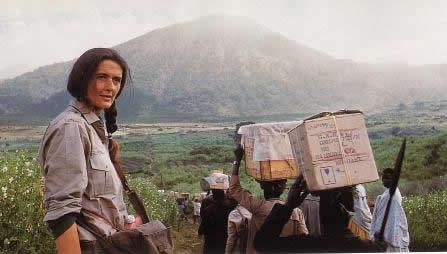 In the 1967, she came to the Virunga conservation area and set up her base between mount Visoke and Karisimbi. She combined the names of the two mountains and formed the Karisoke research Centre. The research Centre started out in a hut and later grew to have pronounced structures. The first gorilla she encountered was a five-year-old male gorilla she named Digit. She observed it closely and they started forming a warm relationship. She embarked on making friends with more gorillas once she had found out that they were gentle and very warm animals. Later on, she carried out the first gorilla census around the Virunga conservation area. The results of the census showed that the number of mountain gorillas had declined drastically and they could become extinct in nothing was done about poaching and habitat encroachment. She brought to the attention of the world the plight of mountain gorillas and alerted wildlife conservation organizations to intervene.
In the 1967, she came to the Virunga conservation area and set up her base between mount Visoke and Karisimbi. She combined the names of the two mountains and formed the Karisoke research Centre. The research Centre started out in a hut and later grew to have pronounced structures. The first gorilla she encountered was a five-year-old male gorilla she named Digit. She observed it closely and they started forming a warm relationship. She embarked on making friends with more gorillas once she had found out that they were gentle and very warm animals. Later on, she carried out the first gorilla census around the Virunga conservation area. The results of the census showed that the number of mountain gorillas had declined drastically and they could become extinct in nothing was done about poaching and habitat encroachment. She brought to the attention of the world the plight of mountain gorillas and alerted wildlife conservation organizations to intervene.
Whereas her initial objective was research, Dian Fossey changed and broadened her work to include gorilla conservation. She came up with three approaches to gorilla conservation – The Proactive, community and theoretical approach. In the proactive approach, she tirelessly fought animal/pet traffickers and poachers. She mobilized her team to destroy snares that had been planted by poachers in gorilla habitats. Dian Fossey also advocated for governments to put up strict laws on poaching. She even treated gorillas which were found sick and injured in the forest. Under the theoretical approach, she put her gorilla research finding in writing and published them in influential journals hence getting the attention of people who were willing to support her work. Support came in form of finance and by people who were willing to volunteer at her research Centre.
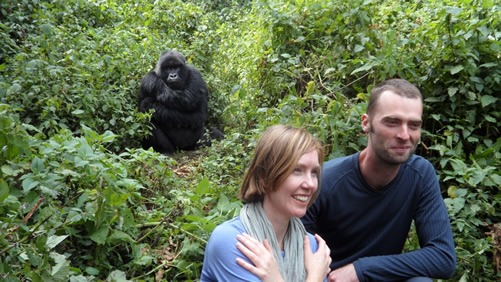 Dian Fossey also encouraged people around the world to come and watch the gorillas in the wild. Although she later frowned upon gorilla tourism and advocated for gorillas to be left alone in the wild, it was Dian Fossey who first introduced the idea of gorilla trekking. Under the community approach, Fossey engaged the local people/community by building social services (schools, hospitals and water sources) using the money got from gorilla tourism. She also employed them at her research Centre hence winning their support in the overall fight against poaching. In the 1985, Dian Fossey was murdered in her Cabin by unknown people. Rumors abound that her murder was an act of revenge from the people who had gained from poaching and animal trafficking.
Dian Fossey also encouraged people around the world to come and watch the gorillas in the wild. Although she later frowned upon gorilla tourism and advocated for gorillas to be left alone in the wild, it was Dian Fossey who first introduced the idea of gorilla trekking. Under the community approach, Fossey engaged the local people/community by building social services (schools, hospitals and water sources) using the money got from gorilla tourism. She also employed them at her research Centre hence winning their support in the overall fight against poaching. In the 1985, Dian Fossey was murdered in her Cabin by unknown people. Rumors abound that her murder was an act of revenge from the people who had gained from poaching and animal trafficking.
Mountain Gorilla Conservation and Current Threats
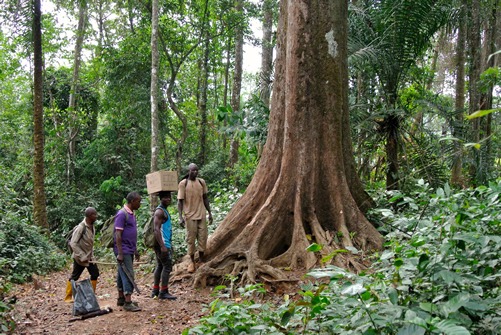 Although the work of Dian Fossey helped eliminate poaching and secure funding for gorilla conservation programs, the number of mountain gorillas has just reached 1,000 from 250 in the 1980’s. They are still listed as endangered by the International Union of Conservation for Nature. They could still quickly reduce in number with a real possibility of extinction. The main threat to mountain gorillas is habitat loss and other human activities. Their natural environment has been encroached upon by humans for settlement, cultivation and charcoal burning.
Although the work of Dian Fossey helped eliminate poaching and secure funding for gorilla conservation programs, the number of mountain gorillas has just reached 1,000 from 250 in the 1980’s. They are still listed as endangered by the International Union of Conservation for Nature. They could still quickly reduce in number with a real possibility of extinction. The main threat to mountain gorillas is habitat loss and other human activities. Their natural environment has been encroached upon by humans for settlement, cultivation and charcoal burning.
Poaching is still prevalent especially in the Democratic Republic of Congo. There are also pet traders still operating in some parts of the Democratic Republic of Congo who would be more than happy to get hold of a baby gorilla. Outbreak of epidemic diseases like cholera and Ebola are real threats to mountain gorillas. These threats have not gone unnoticed by wildlife conservation Agencies. It is why the number of mountain gorillas has been 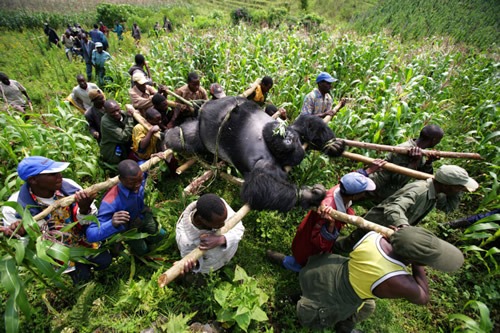 increasing and now stands at about 1000 according to the 2018 census. Different gorilla conservation organizations have been actively supporting the governments of Uganda, Rwanda and Congo. Their support has come in form of funding, offering expatriate staff and raising awareness about mountain gorilla conservation. Some of the notable organization include the Dian Fossey Foundation, International Union of Conservation for Nature (IUCN), Gorilla Fund foundation (GFF) and the United Nations Educational Scientific and cultural organization (UNESCO).
increasing and now stands at about 1000 according to the 2018 census. Different gorilla conservation organizations have been actively supporting the governments of Uganda, Rwanda and Congo. Their support has come in form of funding, offering expatriate staff and raising awareness about mountain gorilla conservation. Some of the notable organization include the Dian Fossey Foundation, International Union of Conservation for Nature (IUCN), Gorilla Fund foundation (GFF) and the United Nations Educational Scientific and cultural organization (UNESCO).
Mountain Gorilla Trekking
In the 1990s, the three governments of Uganda, Rwanda and Congo sat with gorilla conservation organizations and came up with a strategy of making the gorillas known to the world through gorilla tourism. By allowing tourists visit the primates, it would not only raise funds for conservation purposes but also make local communities living close to the gorilla habitats see the value of protecting the primates. Gorilla tourism would help create jobs and bring important projects that would benefit the communities.
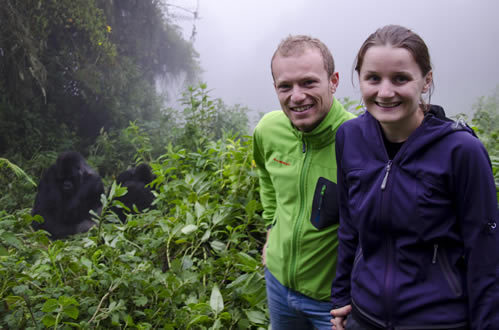 The world embraced the gorilla tourism initiative and right now mountain gorilla trekking is one of the most popular wildlife activities in the world. Thousands of tourists come to Africa each year for gorilla tracking. Many of have been overheard saying it was the most amazing wildlife encounter they had. What is gorilla trekking? Gorilla trekking involves going deep into the jungle of Uganda, Rwanda and Congo in search of a family of mountain gorillas. The activity is led by park Rangers and can take between 2 to 6 hours depending on the gorilla group one is assigned to. Once they find the gorillas, they have only one hour to observe them feed, groom, mate, play and rest. For a more comprehensive experience, one can register for the gorilla habituation experience. This experience is only possible in Bwindi Impenetrable National Park.
The world embraced the gorilla tourism initiative and right now mountain gorilla trekking is one of the most popular wildlife activities in the world. Thousands of tourists come to Africa each year for gorilla tracking. Many of have been overheard saying it was the most amazing wildlife encounter they had. What is gorilla trekking? Gorilla trekking involves going deep into the jungle of Uganda, Rwanda and Congo in search of a family of mountain gorillas. The activity is led by park Rangers and can take between 2 to 6 hours depending on the gorilla group one is assigned to. Once they find the gorillas, they have only one hour to observe them feed, groom, mate, play and rest. For a more comprehensive experience, one can register for the gorilla habituation experience. This experience is only possible in Bwindi Impenetrable National Park.
Gorilla trekking can be booked through a good tour operator but under the overall supervision of the different governmental authorities in the country. The authorities are the Rwanda Development Board, Uganda Wildlife Authority and Virunga National Park in Congo. Gorilla permits in Rwanda cost $1500 while in Uganda it costs $700. Gorilla permits in Congo cost $450. An international traveler also has to consider the cost of air-tickets, visas, accommodation, meals and transport. Most tour operators will share the overall cost of gorilla trekking which includes everything except for Air-rickets, Visas and personal expenses.

